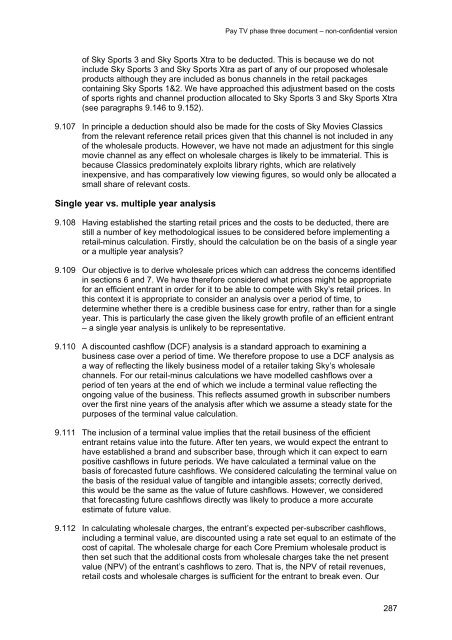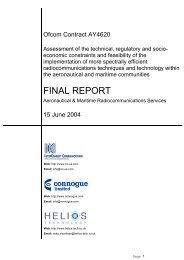Pay TV phase three document - Stakeholders - Ofcom
Pay TV phase three document - Stakeholders - Ofcom
Pay TV phase three document - Stakeholders - Ofcom
You also want an ePaper? Increase the reach of your titles
YUMPU automatically turns print PDFs into web optimized ePapers that Google loves.
<strong>Pay</strong> <strong>TV</strong> <strong>phase</strong> <strong>three</strong> <strong>document</strong> – non-confidential version<br />
of Sky Sports 3 and Sky Sports Xtra to be deducted. This is because we do not<br />
include Sky Sports 3 and Sky Sports Xtra as part of any of our proposed wholesale<br />
products although they are included as bonus channels in the retail packages<br />
containing Sky Sports 1&2. We have approached this adjustment based on the costs<br />
of sports rights and channel production allocated to Sky Sports 3 and Sky Sports Xtra<br />
(see paragraphs 9.146 to 9.152).<br />
9.107 In principle a deduction should also be made for the costs of Sky Movies Classics<br />
from the relevant reference retail prices given that this channel is not included in any<br />
of the wholesale products. However, we have not made an adjustment for this single<br />
movie channel as any effect on wholesale charges is likely to be immaterial. This is<br />
because Classics predominately exploits library rights, which are relatively<br />
inexpensive, and has comparatively low viewing figures, so would only be allocated a<br />
small share of relevant costs.<br />
Single year vs. multiple year analysis<br />
9.108 Having established the starting retail prices and the costs to be deducted, there are<br />
still a number of key methodological issues to be considered before implementing a<br />
retail-minus calculation. Firstly, should the calculation be on the basis of a single year<br />
or a multiple year analysis?<br />
9.109 Our objective is to derive wholesale prices which can address the concerns identified<br />
in sections 6 and 7. We have therefore considered what prices might be appropriate<br />
for an efficient entrant in order for it to be able to compete with Sky’s retail prices. In<br />
this context it is appropriate to consider an analysis over a period of time, to<br />
determine whether there is a credible business case for entry, rather than for a single<br />
year. This is particularly the case given the likely growth profile of an efficient entrant<br />
– a single year analysis is unlikely to be representative.<br />
9.110 A discounted cashflow (DCF) analysis is a standard approach to examining a<br />
business case over a period of time. We therefore propose to use a DCF analysis as<br />
a way of reflecting the likely business model of a retailer taking Sky’s wholesale<br />
channels. For our retail-minus calculations we have modelled cashflows over a<br />
period of ten years at the end of which we include a terminal value reflecting the<br />
ongoing value of the business. This reflects assumed growth in subscriber numbers<br />
over the first nine years of the analysis after which we assume a steady state for the<br />
purposes of the terminal value calculation.<br />
9.111 The inclusion of a terminal value implies that the retail business of the efficient<br />
entrant retains value into the future. After ten years, we would expect the entrant to<br />
have established a brand and subscriber base, through which it can expect to earn<br />
positive cashflows in future periods. We have calculated a terminal value on the<br />
basis of forecasted future cashflows. We considered calculating the terminal value on<br />
the basis of the residual value of tangible and intangible assets; correctly derived,<br />
this would be the same as the value of future cashflows. However, we considered<br />
that forecasting future cashflows directly was likely to produce a more accurate<br />
estimate of future value.<br />
9.112 In calculating wholesale charges, the entrant’s expected per-subscriber cashflows,<br />
including a terminal value, are discounted using a rate set equal to an estimate of the<br />
cost of capital. The wholesale charge for each Core Premium wholesale product is<br />
then set such that the additional costs from wholesale charges take the net present<br />
value (NPV) of the entrant’s cashflows to zero. That is, the NPV of retail revenues,<br />
retail costs and wholesale charges is sufficient for the entrant to break even. Our<br />
287
















